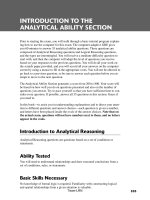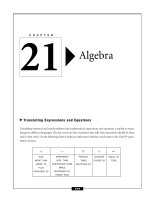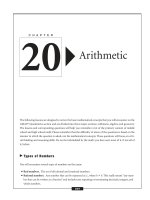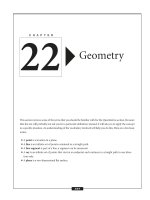The GMAT Quantitative Section - Algebra
Bạn đang xem bản rút gọn của tài liệu. Xem và tải ngay bản đầy đủ của tài liệu tại đây (144.94 KB, 18 trang )
Translating Expressions and Equations
Translating sentences and word problems into mathematical expressions and equations is similar to trans-
lating two different languages. The key words are the vocabulary that tells what operations should be done
and in what order. Use the following chart to help you with some of the key words used on the GMAT® quan-
titative section.
SUM
MORE THAN
ADDED TO
PLUS
INCREASED BY
PRODUCT
TIMES
MULTIPLIED BY
QUOTIENT
DIVIDED BY
EQUAL TO
TOTAL
DIFFERENCE
LESS THAN
SUBTRACTED FROM
MINUS
DECREASED BY
FEWER THAN
Ϭ
ϩ
Ϫϫ
ϭ
CHAPTER
Algebra
21
339
The following is an example of a problem where knowing the key words is necessary:
Fifteen less than five times a number is equal to the product of ten and the number. What is the
number?
Translate the sentence piece by piece:
Fift
ee
n less than five times the numb
er equals the pro
duct of 10 and
x.
5x – 15 = 10x
The equation is 5x – 15 = 10x
Subtract 5x from both sides: 5x – 5x – 15 = 10x – 5x
Divide both sides by 5:
–3 = x
It is important to realize that the key words less than tell you to subtract from the number and the key
word product reminds you to multiply.
Combining Like Terms and Polynomials
In algebra, you use a letter to represent an unknown quantity. This letter is called the variable. The number
preceding the variable is called the coefficient. If a number is not written in front of the variable, the coeffi-
cient is understood to be one. If any coefficient or variable is raised to a power, this number is the exponent.
3x Three is the coefficient and x is the variable.
xy One is the coefficient, and both x and y are the variables.
–2x
3
y Negative two is the coefficient, x and y are the variables, and three is the exponent of x.
Another important concept to recognize is like terms. In algebra, like terms are expressions that have
exactly the same variable(s) to the same power and can be combined easily by adding or subtracting the coef-
ficients.
Examples
3x + 5x These terms are like terms, and the sum is 8x.
4x
2
y + –10x
2
y These terms are also like terms, and the sum is –6x
2
y.
2xy
2
+ 9x
2
y These terms are not like terms because the variables, taken with their powers,
are not exactly the same. They cannot be combined.
–15
5
ϭ
5x
5
–
ALGEBRA
–
340
A polynomial is the sum or difference of many terms and some have specific names:
8x
2
This is a monomial because there is one term.
3x + 2y This is a binomial because there are two terms.
4x
2
+ 2x – 6 This is a trinomial because there are three terms.
Laws of Exponents
■
When multiplying like bases, add the exponents: x
2
× x
3
= x
2 + 3
= x
5
■
When dividing like bases, subtract the exponents:
■
When raising a power to another power, multiply the exponents:
■
Remember that a fractional exponent means the root: ͙
ෆ
x = x
ᎏ
1
2
ᎏ
and ͙
3
x
ෆ
= x
ᎏ
1
3
ᎏ
The following is an example of a question involving exponents:
Solve for x:2
x + 2
= 8
3
.
a. 1
b. 3
c. 5
d. 7
e. 9
The correct answer is d. To solve this type of equation, each side must have the same base. Since 8 can
be expressed as 2
3
, then 8
3
= (2
3
)
3
= 2
9
. Both sides of the equation have a common base of 2, so set the expo-
nents equal to each other to solve for x. x + 2 = 9. So, x = 7.
Solving Linear Equations of One Variable
When solving this type of equation, it is important to remember two basic properties:
■
If a number is added to or subtracted from one side of an equation, it must be added to or subtracted
from the other side.
■
If a number is multiplied or divided on one side of an equation, it must also be multiplied or divided
on the other side.
1x
2
2
3
ϭ x
2 ϫ 3
ϭ x
6
x
5
x
2
= x
5 – 2
= x
3
–
ALGEBRA
–
341
Linear equations can be solved in four basic steps:
1. Remove parentheses by using distributive property.
2. Combine like terms on the same side of the equal sign.
3. Move the variables to one side of the equation.
4. Solve the one- or two-step equation that remains, remembering the two previous properties.
Examples
Solve for x in each of the following equations:
a. 3x – 5 = 10
Add 5 to both sides of the equation: 3x – 5 + 5 = 10 + 5
Divide both sides by 3:
x = 5
b. 3 (x – 1) + x = 1
Use distributive property to remove parentheses:
3x – 3 + x = 1
Combine like terms: 4x – 3 = 1
Add 3 to both sides of the equation: 4x – 3 + 3 = 1 + 3
Divide both sides by 4:
x = 1
c. 8x – 2 = 8 + 3x
Subtract 3x from both sides of the equation to move the variables to one side:
8x – 3x – 2 = 8 + 3x – 3x
Add 2 to both sides of the equation: 5x – 2 + 2 = 8 + 2
Divide both sides by 5:
x = 2
Solving Literal Equations
A literal equation is an equation that contains two or more variables. It may be in the form of a formula. You
may be asked to solve a literal equation for one variable in terms of the other variables. Use the same steps
that you used to solve linear equations.
5x
5
ϭ
10
5
4x
4
ϭ
4
4
3x
3
ϭ
15
3
–
ALGEBRA
–
342
Example
Solve for x in terms of a and b:2x + b = a
Subtract b from both sides of the equation: 2x + b – b = a – b
Divide both sides of the equation by 2:
Solving Inequalities
Solving inequalities is very similar to solving equations. The four symbols used when solving inequalities are
as follows:
■
Ͻ is less than
■
Ͼ is greater than
■
Յ is less than or equal to
■
Ն is greater than or equal to
When solving inequalities, there is one catch: If you are multiplying or dividing each side by a negative
number, you must reverse the direction of the inequality symbol. For example, solve the inequality
–3x + 6 Յ 18:
1. First subtract 6 from both sides:
2. Then divide both sides by –3:
3. The inequality symbol now changes:
Solving Compound Inequalities
A compound inequality is a combination of two inequalities. For example, take the compound inequality
–3 Ͻ x + 1 Ͻ 4. To solve this, subtract 1 from all parts of the inequality. –3 – 1 Ͻ x + 1 – 1 Ͻ 4 – 1. Simplify.
–4 Ͻ x Ͻ 3. Therefore, the solution set is all numbers between –4 and 3, not including –4 and 3.
x ՆϪ4
–3x
–3
Յ
12
–3
–3x ϩ 6 Ϫ 6 Յ 18 Ϫ 6
x ϭ
a Ϫ b
2
2x
2
ϭ
a Ϫ b
2
–
ALGEBRA
–
343
Multiplying and Factoring Polynomials
When multiplying by a monomial, use the distributive property to simplify.
Examples
Multiply each of the following:
1. (6x
3
)(5xy
2
) = 30x
4
y
2
(Remember that x = x
1
.)
2. 2x (x
2
– 3) = 2x
3
– 6x
3. x
3
(3x
2
+ 4x – 2) = 3x
5
+ 4x
4
– 2x
3
When multiplying two binomials, use an acronym called FOIL.
F Multiply the first terms in each set of parentheses.
O Multiply the outer terms in the parentheses.
I Multiply the inner terms in the parentheses.
L Multiply the last terms in the parentheses.
Examples
1. (x – 1)(x + 2) = x
2
+ 2x – 1x – 2 = x
2
+ x – 2
F O I L
2. (a – b)
2
= (a – b)(a – b) = a
2
– ab – ab – b
2
F O I L
Factoring Polynomials
Factoring polynomials is the reverse of multiplying them together.
Examples
Factor the following:
1. 2x
3
+ 2 = 2 (x
3
+ 1) Take out the common factor of 2.
2. x
2
– 9 = (x + 3)(x – 3) Factor the difference between two perfect squares.
3. 2x
2
+ 5x – 3 = (2x – 1)(x + 3) Factor using FOIL backwards.
4. 2x
2
– 50 = 2(x
2
– 25) = 2(x + 5)(x – 5) First take out the common factor and then factor the difference
between two squares.
Solving Quadratic Equations
An equation in the form y = ax
2
+ bx + c,where a, b, and c are real numbers, is a quadratic equation. In other
words, the greatest exponent on x is two.
–
ALGEBRA
–
344
Quadratic equations can be solved in two ways: factoring, if it is possible for that equation, or using the
quadratic formula.
By Factoring
In order to factor the quadratic equation, it first needs to be in standard form. This form is y = ax
2
+bx + c.
In most cases, the factors of the equations involve two numbers whose sum is b and product is c.
Examples
Solve for x in the following equation:
1. x
2
– 25 = 0
This equation is already in standard form. This equation is a special case; it is the difference
between two perfect squares. To factor this, find the square root of both terms.
The square root of the first term x
2
is x.
The square root of the second term 25 is 5.
Then two factors are x – 5 and x + 5.
The equation x
2
– 25 = 0
then becomes (x – 5)(x + 5) = 0
Set each factor equal to zero and solve x – 5 = 0 or x + 5 = 0
x = 5 or x = –5
The solution is {5, –5}.
2. x
2
+ 6x = –9
This equation needs to be put into standard form by adding 9 to both sides
of the equation. x
2
+ 6x + 9 = –9 + 9
x
2
+ 6x + 9 = 0
The factors of this trinomial will be two numbers whose sum is 6 and whose product is 9. The fac-
tors are x + 3 and x + 3 because 3 + 3 = 6 and 3 × 3 = 9.
The equation becomes (x + 3)(x + 3) = 0
Set each factor equal to zero and solve x + 3 = 0 or x + 3 = 0
x = –3 or x = –3
Because both factors were the same, this was a perfect square trinomial. The solution is {–3}.
3. x
2
= 12 + x
This equation needs to be put into standard form by subtracting 12 and x from both sides of the
equation. x
2
– x – 12 = 12 – 12 + x – x
x
2
– x – 12 = 0
–
ALGEBRA
–
345









